Chai-pani
Hot and cold drinks
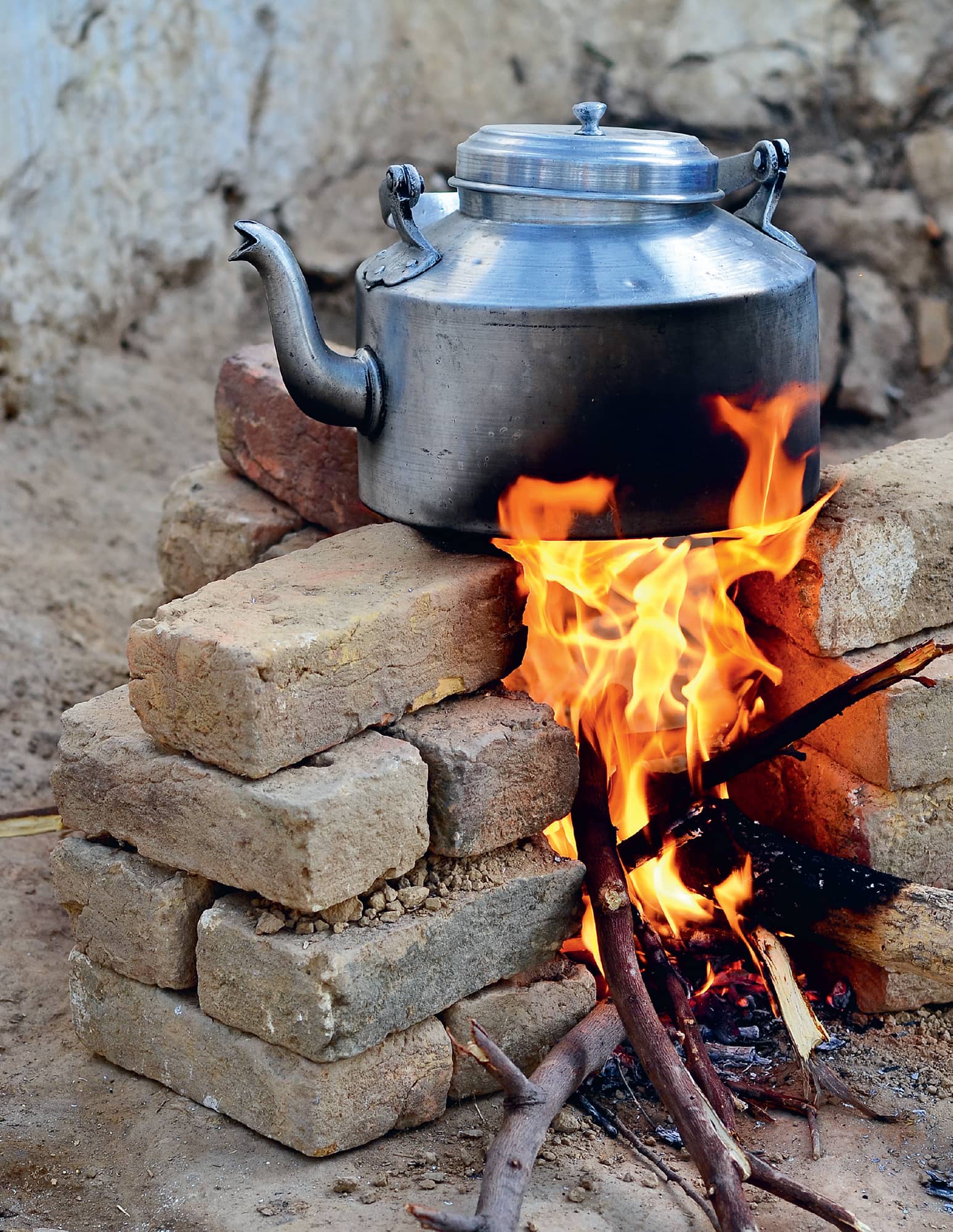
A cup of cardamom chai cures all woes.
In the same way the British love a ‘cuppa’, much of the fabric of Pakistani social culture revolves around the quintessential cup of tea. It brings people together as they take respite from the heat and find solace in a cup of slow-brewed chai.
‘Chai-pani’ is an expression with a dual meaning: it literally translates as ‘tea and water’, but is both a friendly invitation to a friend for a catch-up, and the repayment of a favour. With the promise of either a hot or cool drink, the meeting is sweeter, the favour is returned satisfactorily. No matter the sentiment, a ‘garam’ (warm) chai or a ‘thandi’ (cool) lassi soothes the Pakistani soul.
A memory that has never left me is one of makeshift roadside stoves brewing the Pathan chai of the people from the north of Pakistan, served in small enamel teapots and poured into glass tumblers. Hot days were made bearable with soothing warm chai, fresh buffalo milk lassi or ‘dooth ki botel’, a drink made with raw milk, ground nuts and poppy seeds.
This chapter brings together hot and cold beverages that tap into the emotions and flavours of Pakistan. Some are easy to make, others need a little work to source ingredients, but each brings with it a true taste of the country, one sip at a time.
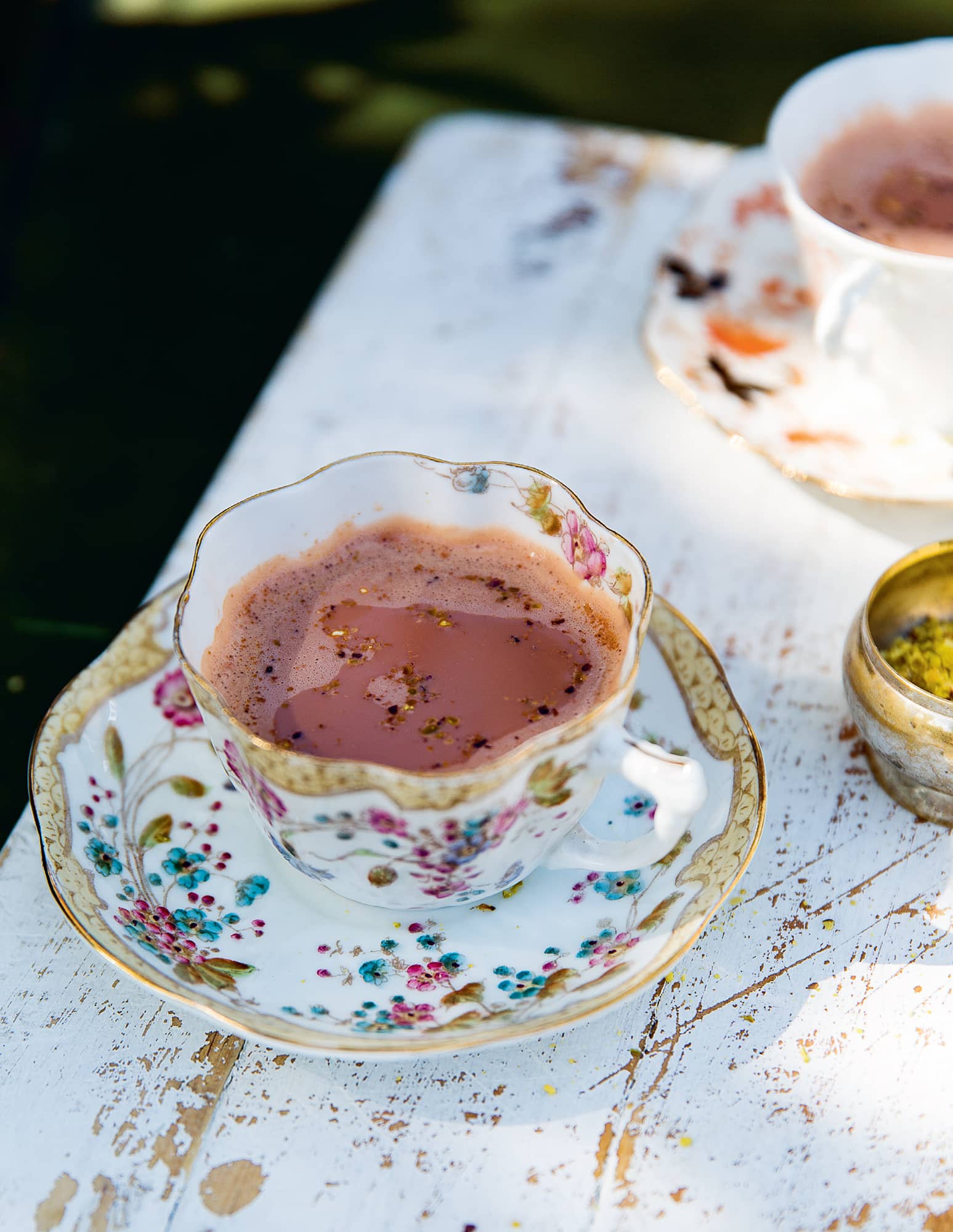
◁ Noon chai
Kashmiri-inspired pink tea
Big, hot cauldrons of this salty sweet pistachio-topped tea would brew for hours during the late-night festivities which are so common in Pakistan. The savoury-sweet flavour is an acquired taste – if you like it, it’s best enjoyed as a nightcap, though it can be made without the salt if you prefer.
Preparation 10 minutes | Cooking 10–15 minutes | Serves 4–6
2 tsp Kashmiri tea leaves or pure green tea leaves (this is a family version, and can be substituted if Kashmiri tea leaves are not available)
350–475ml/12–16 fl oz/1 1/2–2 cups water
1/4– 1/2 tsp bicarbonate of soda (baking soda)
2–3 green cardamom pods, seeds removed and roughly crushed
1 litre/1 3/4 pints/4 cups whole milk
1/4– 1/2 tsp sea salt OR sugar if you prefer
To garnish
Mix together 2 tsp each ground pistachios and almonds and 1 tsp poppy seeds
Put 2 teaspoons of the tea in a saucepan over medium heat with about half of the measured water and bring to the boil. Boil until frothy then add the bicarbonate of soda and whisk vigorously for about 10 seconds. Add the remaining water and the crushed cardamom and boil until the tea broth becomes a bright red colour.
Reduce the heat to medium low and add the milk. Using a whisk, whisk the tea broth very vigorously to achieve a slight froth. The colour of the tea should now be dark pink. If you add more milk, the colour becomes even lighter.
Finally, add the salt or sugar and stir. Pour into a cup and sprinkle with the mixed crushed pistachios, almonds and poppy seeds.
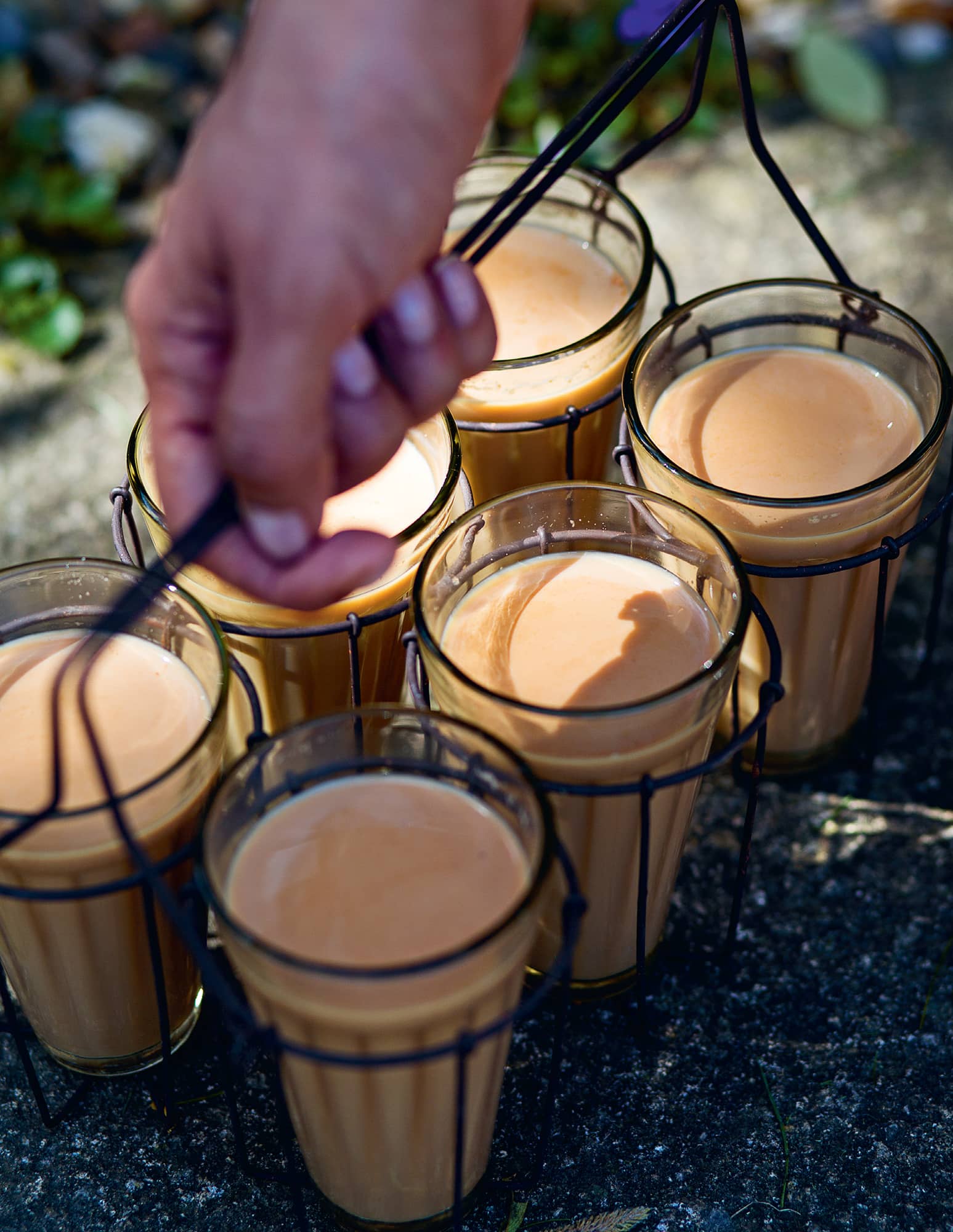
◁ Elaichi chai
Cardamom milky tea
The true chai of Pakistan, this slow-brewed milky tea should be made with loads of heady cardamom.
Preparation 10 minutes | Cooking 15 minutes | Serves 4–6
3 tsp Assam tea leaves
500ml/17 fl oz/2 cups water
5 green cardamom pods, crushed
500ml/17 fl oz/2 cups whole milk
4 tbsp caster (superfine) sugar (or to taste)
Put the tea, water and cardamom into a large saucepan and bring to the boil. When it comes to the boil, add the milk and return to the boil. Once that reaches the boil, reduce the heat to very low and simmer for 10 minutes.
Add the sugar and stir. Simmer for a further 5 minutes. Add more milk or sugar, if liked.
Pour through a sieve into a cup or glass and serve hot.
Rose milkshake
Children growing up in Pakistan were often promised a treat of rooh afza dooth – milk mixed with a rose, herb and spice syrup which can be bought in almost all Asian stores. You can use the store-bought syrup if you can find it, but homemade rose syrup makes a refreshing alternative.
Preparation 1 hour Cooking 5 minutes + cooling | Serves 8–10
For the rooh afza-style syrup (makes about 1 litre/1 3/4 pints/4 cups)
1 litre/1 3/4 pints/4 cups water
250g/9oz/1 1/4 cups caster (superfine) sugar
10g/1/3oz gum – Arabic gum, finely crushed then dissolved in hot water and cooled
1/2 tsp crushed aniseed
1cm/ 1/2-inch cinnamon stick
1/2 tsp crushed cardamom seeds
3–4 tsp rose water
2–4 drops red natural food colour
For the rooh afza-style milk
2–3 tbsp Rooh Afza-style syrup
250ml/9 fl oz/1 cup whole milk
1 tbsp basil seeds, soaked for 15 minutes
To make the rooh afza-style syrup, bring the water with the sugar and add the dissolved gum, aniseed, cinnamon and cardamom to the boil in a saucepan, then turn off the heat. Add the rose water and food colour and allow to cool.
Strain the mixture through a sieve and pour into a sterilised bottle. Store in the fridge and use within 7 days.
To make the milk, add 3 tablespoons of the syrup with the milk into a blender and blend until frothy. Adjust the sweetness, if liked. Pour into a glass with ice cubes and top with soaked basil seeds.
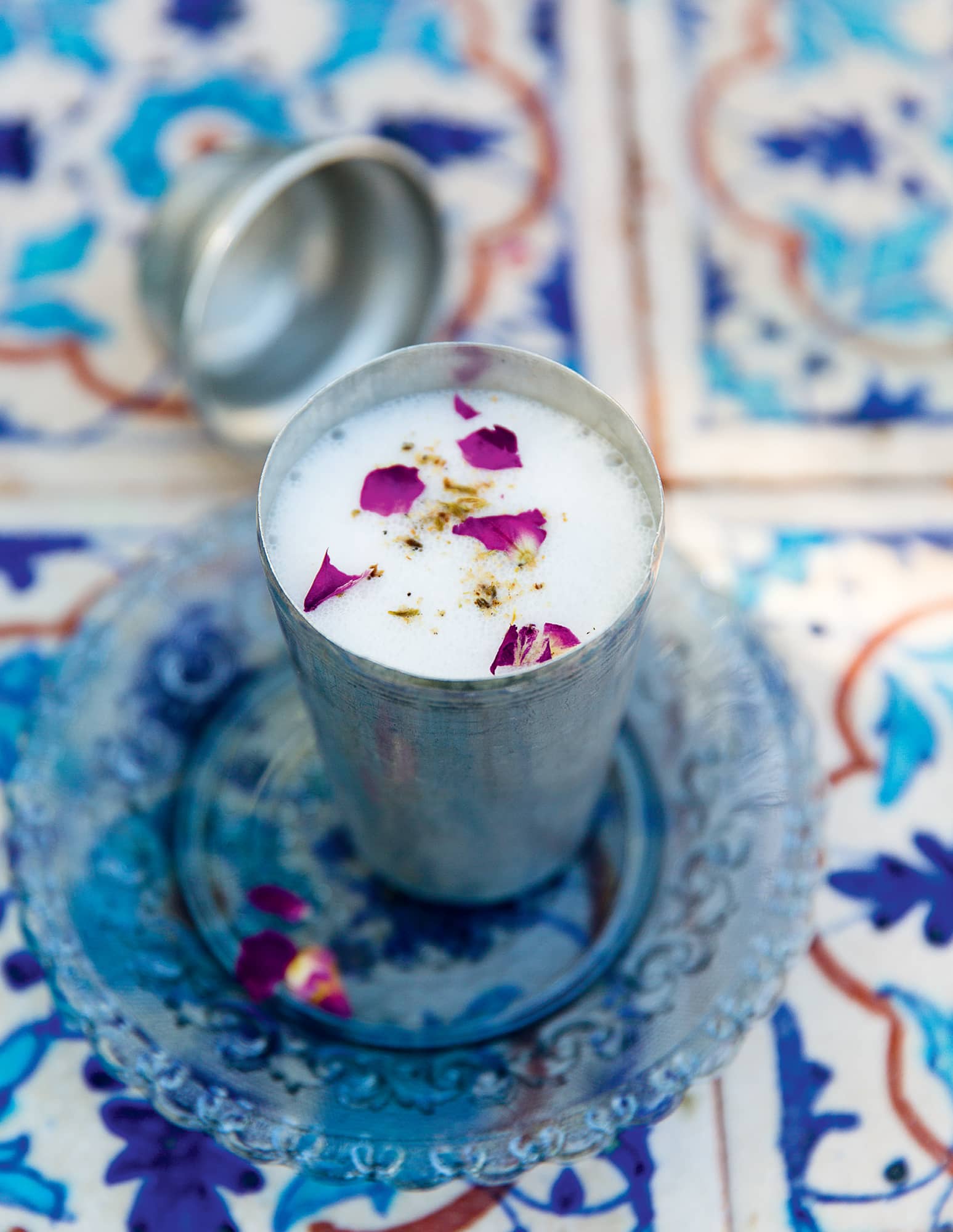
◁ Sindhi thadal
Almond milk, poppy seed and aniseed
Soothing for the soul and based on a classic Sindhi recipe, this nutty drink is made by soaking and grinding almonds to create a milk. It’s then spiced with ground aniseed, poppy seeds and a hint of rose water.
Preparation 15 minutes + overnight soaking | Cooking 10 minutes | Serves 4
150g/5 1/2oz/1 cup blanched almonds, 500ml/17 fl oz/2 cups boiling water
50g/1 3/4 oz/ 1/4 cup caster (superfine) sugar, or to taste
500–750ml/17–26 fl oz/2–3 cups water
1 litre/1 3/4 pints/4 cups ice-cold water
1 tbsp white poppy seeds
2 tsp aniseed, ground
1 tbsp dried edible rose petals, crushed by hand and sprinkled on top
In a bowl, soak the almonds in the measured boiling water in the fridge overnight. The next day, blend the soaked almonds with their soaking water into a very fine paste.
Put the sugar with the 500–750ml/17–26 fl oz/2–3 cups water in a saucepan and heat gently over a low heat until the sugar has dissolved and a syrup has formed.
Combine the almond paste with the measured ice-cold water and the sugar syrup. Chill in the fridge for a few hours.
To serve, stir in the poppy seeds and crushed aniseed, sprinkle with rose petals, then pour over ice cubes.
Spiced sugarcane juice
With kalanamak and ginger
Summer in Pakistan sees stallholders bring out their sugarcane juice presses. The juice is freshly squeezed then laced with a kalanamak (black salt) and ginger for a kick – the perfect way to bring relief from the sun.
Preparation 20 minutes | Serves 4
200ml/7 fl oz/scant 1 cup freshly squeezed sugarcane juice, or store-bought
1/2 tsp kalanamak (black salt)
1cm/ 1/2-inch piece ginger, peeled
Blend all the ingredients together in a blender until frothy. Serve over ice cubes.
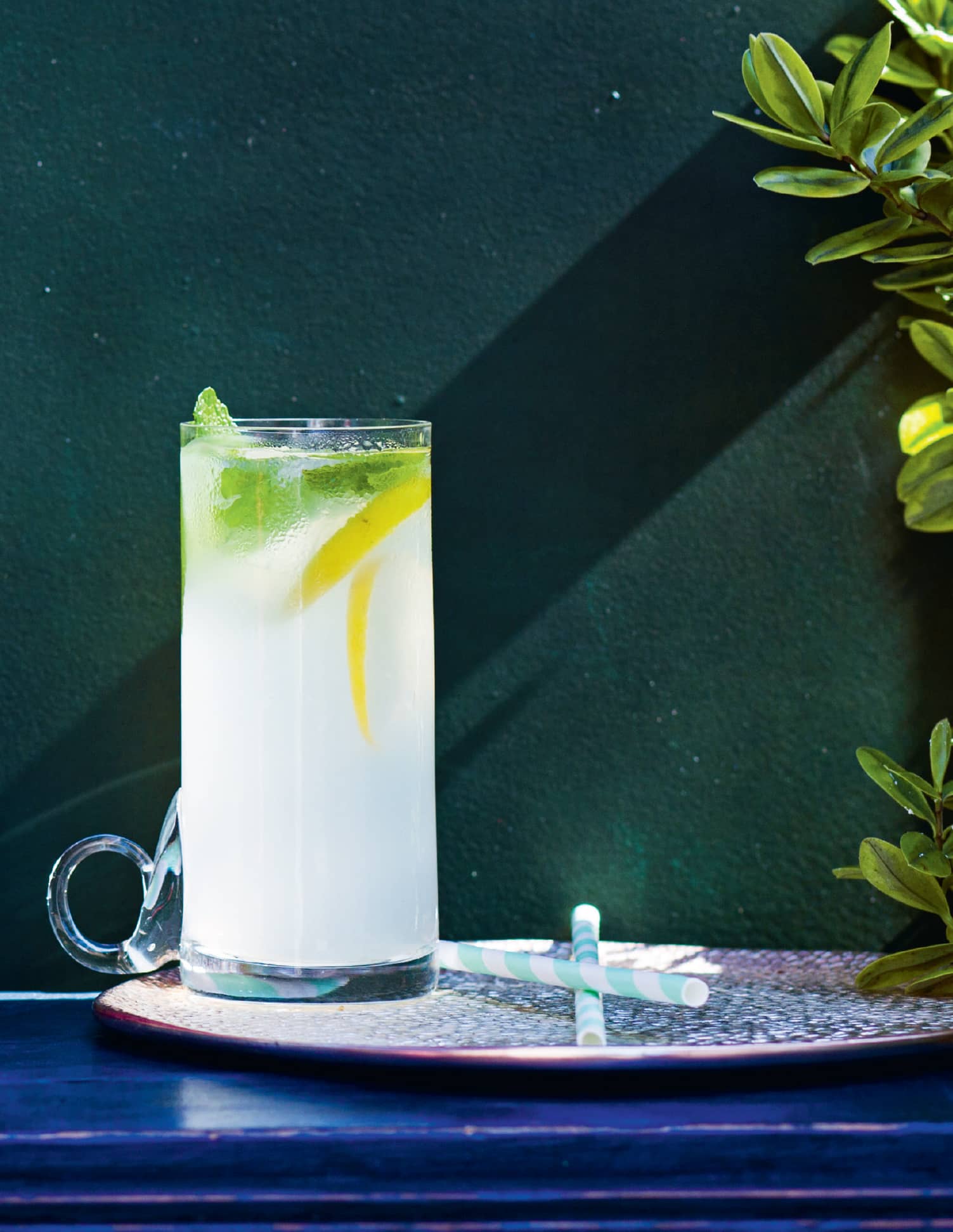
◁ Nimbopani
Lemonade with salt and sugar
A simple combination of small yellow Pakistani lemons with sugar, salt and mint makes a refreshing drink that gently brings solace in a Pakistani summer. You can find these intensely citrusy lemons in Asian stores, but this can be made with any lemons.
Preparation 15 minutes | Serves 6–8
6 small South Asian lemons or 3 large lemons, squeezed
4–5 tbsp caster (superfine) sugar (or to taste)
1 1/2 tsp sea salt
5 mint leaves, plus extra to garnish
lemon slices, to garnish
Blend all the ingredients except for the mint leaves in a blender until frothy.
Add the mint leaves and blend for 5 seconds. Serve over ice cubes garnished with mint leaves and lemon slices.
Cardamom and coconut mattha lassi
This is a typical Punjabi lassi which is made using full-cream, unhomogenised milk and full-cream yogurt – no water is added. I have added cardamom and used coconut yogurt. You could also just use plain Greek yogurt with desiccated coconut.
Preparation 10 minutes | Serves 2
250g/9oz/1 cup coconut whole milk yogurt (or use 250g/9oz/ 1 cup Greek yogurt with 2 tbsp desiccated/dry unsweetened coconut)
3 cardamom pods, seeds removed and finely crushed
200ml/7 fl oz/scant 1 cup whole unhomogenised milk
caster (superfine) sugar, to taste
Blend all the ingredients in a blender until very frothy, then serve over lots of ice cubes.
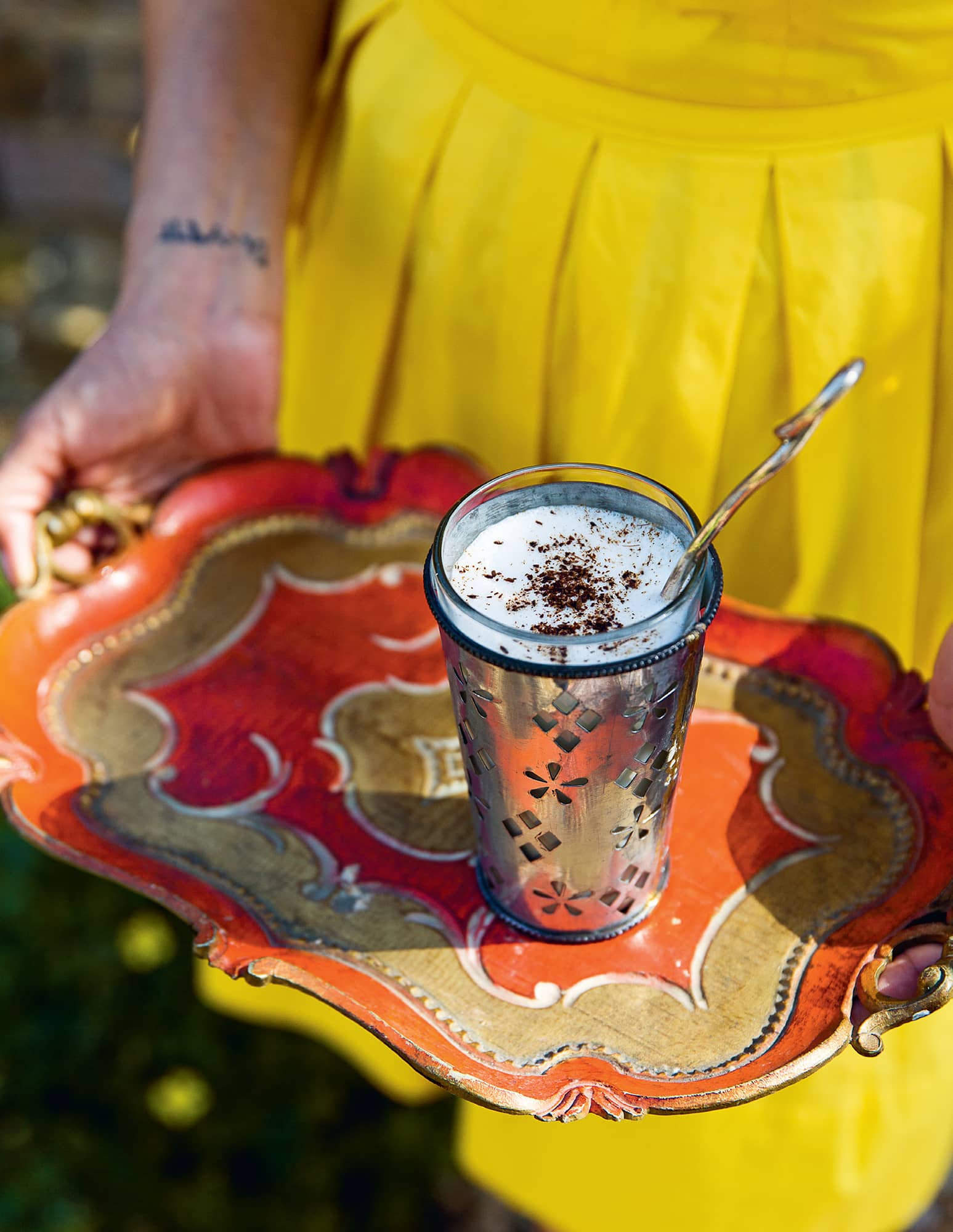
◁ Salty lassi with cumin
Pakistani lassi is salty when paired with food, and sweet when drunk as a refresher between meals. The frothy topping comes from a lot of blending, which is traditionally done with a wooden hand whisk, but can be achieved with a blender. Using whole milk and yogurt works best.
Preparation 10 minutes | Serves 4–6
250g/9oz/1 cup whole set yogurt
25ml/1 fl oz/2 tbsp whole creamy unhomogenised milk
1/2 tsp salt
1 tsp caster (superfine) sugar
1/2 tsp dry-roasted cumin seeds
Blend all the ingredients, except the cumin, in a blender until frothy. Pour over ice cubes and garnish with the cumin. The addition of the cumin brings out the drink’s saltiness.
Kanji
Mustard-fermented carrot and beetroot drink
This is a recipe that’s made in northern Punjab and one that my aunts prepared with blood-red Pakistani carrots (which only grow in winter). No other carrots come close in colour or flavour, but if lacking these, I add beetroot, which gives the drink a similar redness as well as a lovely tang.
Preparation 15 minutes + 3–5 days fermenting | Makes About 2 litres/3 1/2 pints/8 cups
5 carrots, cut into long 5cm/2-inch pieces
1 beetroot, peeled and cut into 4 pieces
juice of 1/2 lemon
2 litres/3 1/2 pints/8 cups water
1 tsp red chilli powder
3 tbsp yellow mustard seeds, roughly ground in a mortar and pestle
1 tsp kalanamak (black salt)
Put the carrots, beetroot and the remaining ingredients into a large ceramic bowl or jar and cover with a lid or muslin cloth.
Place in a sunny or warm place for 3–5 days, stirring every day with a wooden spoon (not metallic, as it reacts with the pickling liquid) until mixed.
Taste each day and when it tastes sour, the kanji is fermented and is ready. Strain the fermented liquid and serve cool over ice cubes.
Any left over carrots and beetroot can be served as a delish relish.
Aam panna ▷
Raw mango sherbert
You can freeze this sherbert in ice-cube trays – when you want a drink, pop a few cubes into a jug, add water to dilute and serve. Truly nothing else cools the body and calms the mind like a cold glass of aam panna.
Preparation 30–40 minutes | Serves 8–10
3 raw green mangos
150g/5 1/2oz/ 1/2 cup caster (superfine) sugar
1 tsp ground ginger
1/2 kalanamak (black salt)
1 tsp salt
250ml/9 fl oz/1 cup water
Preheat the oven to 160°C/325°F/gas mark 3. Cover each raw mango with foil and place in the oven for about 25–30 minutes, or until the mangos are soft. Remove, allow to cool then peel off the skin and set the flesh aside.
Make a syrup with the sugar by adding 300ml/10 fl oz/1 1/4 cups water, or enough to cover the sugar in a saucepan and heating until the sugar melts.
Using your hands, squeeze the mango flesh into a bowl. Add all the spices and seasonings and mix together. Add the sugar syrup and stir. You can now either freeze all the mixture or use now.
To make the drink, add 1–2 tablespoons of the mixture to a blender with 2 ice cubes and the measured water and blend until frothy. Serve with more ice or add more of the mango mixture if you prefer. Adjust the seasoning to taste.
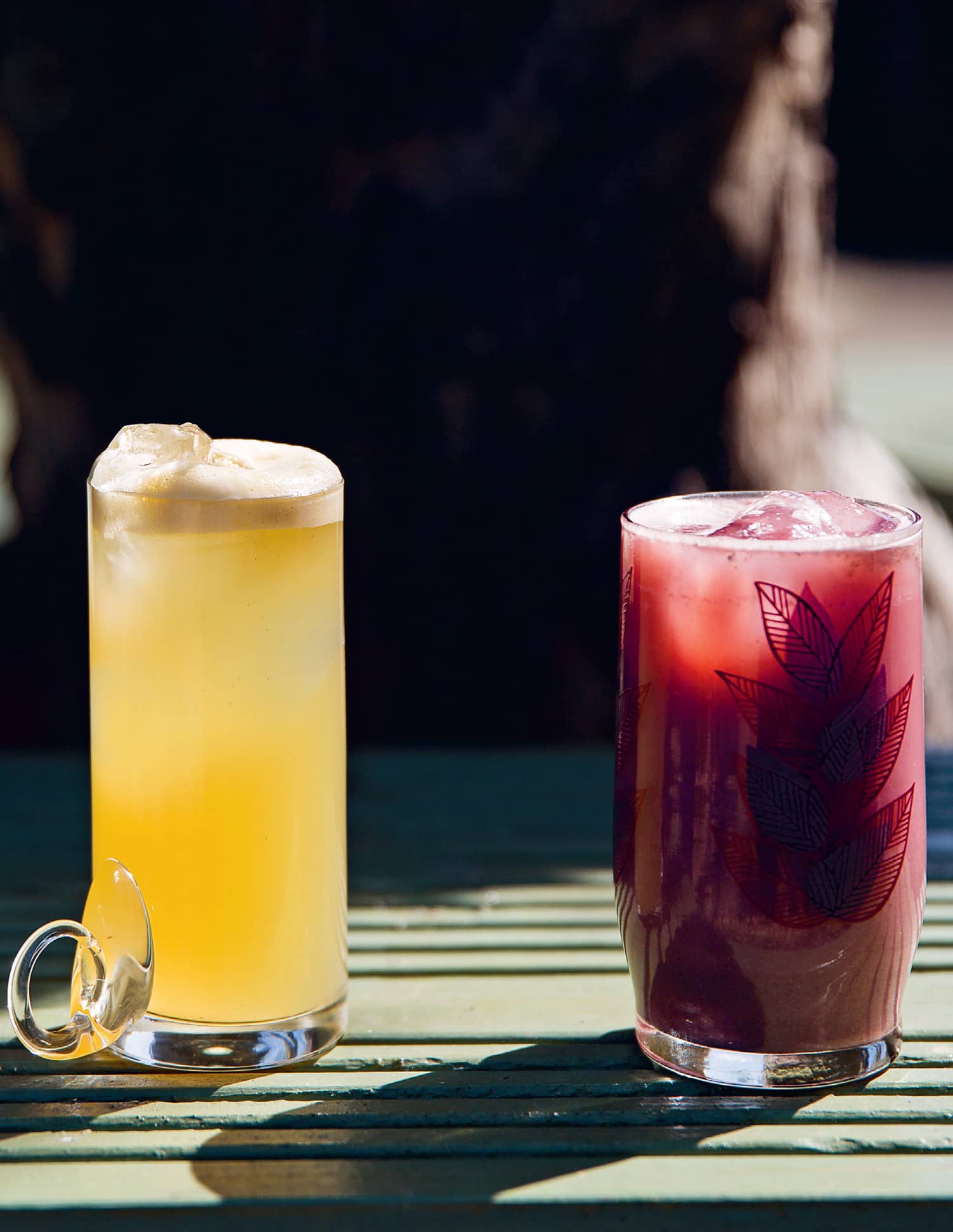
◁ Spiced pomegranate sharbat
Sharbat is a sweet fresh juice, and this one is a particular favourite. It’s made with freshly blended pomegranates with a touch of spice. You can make it ahead of time during pomegranate season and freeze. If you find it too strong when defrosted, add loads of ice to dilute.
Preparation 10 minutes | Serves 4–6
2 pomegranates, shelled, juice squeezed and seeds discarded
1/2 tsp dried ginger
2 tsp dry-roasted ground cumin seeds
1/2 tsp salt
1/2 tsp chaat masala see here
1/4 tsp ground black pepper
Blend all the ingredients in a blender until frothy then strain and pour over ice cubes to serve.
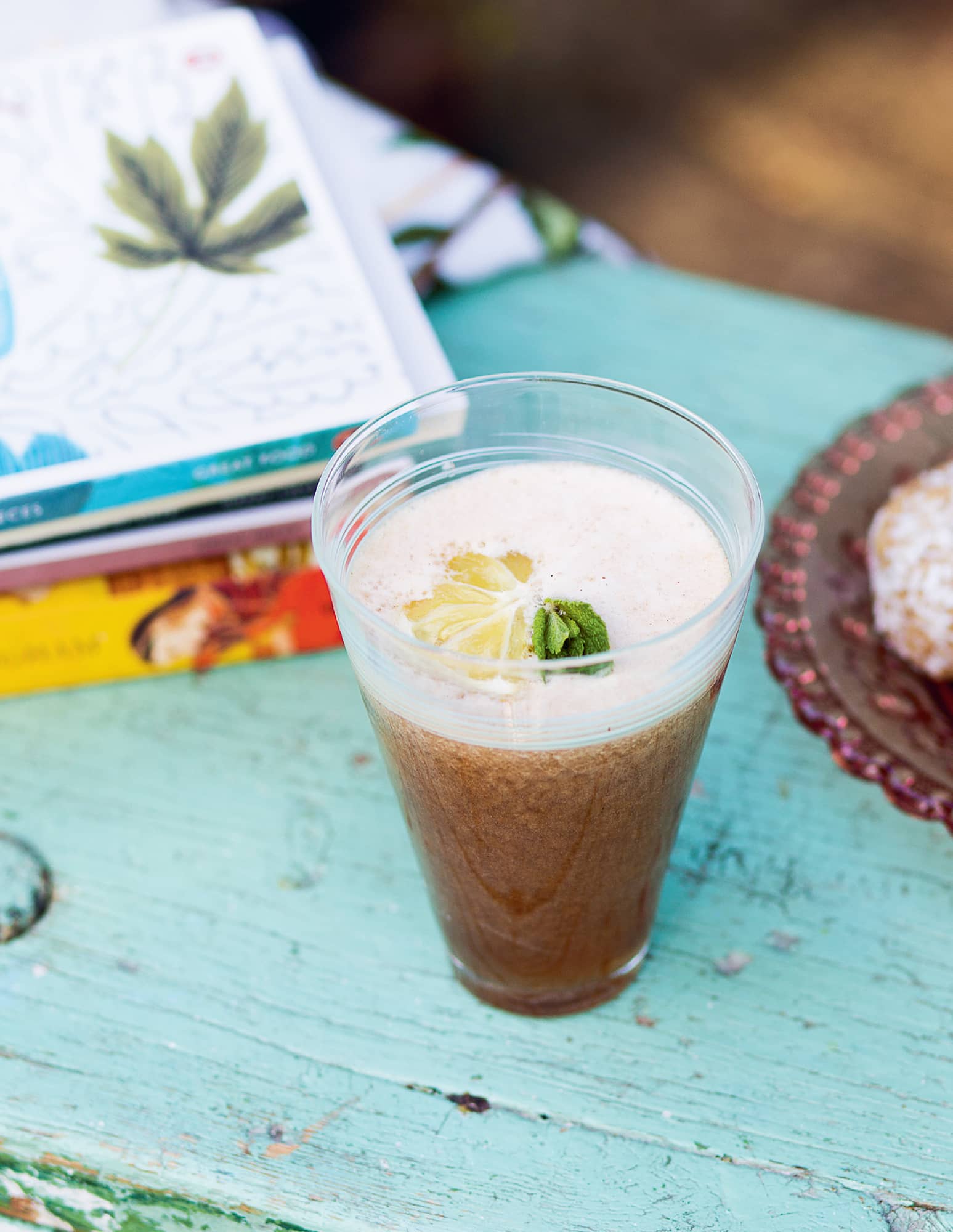
◁ Summers under the tamarind tree
Spiced tamarind drink
After a day of picking fresh fruit from my Nani’s (maternal grandmother) evergreen tamarind tree, I’d always be treated with this piquant drink – the ultimate remedy for tiredness. This drink alone is the best memory of the many childhood summers I spent lounging under her tamarind tree. Savouring each sip, I would sit on my Nani’s breezy veranda, catching her distant chatter with my mother from the kitchen as they cooked. I never learned to cook by penning down recipes – it was during such moments when I unknowingly absorbed the sounds, sights and aromas of the food, made with passion and generosity in my home. It’s those valuable lessons that bring to life the food that I know and love as Pakistani, and which I look forward to passing on to my daughter.
Preparation 15 minutes + 15 minutes soaking + 30 minutes chilling | Serves 4
4 tbsp tamarind pulp (from 200g/7oz dried or fresh tamarind, see here)
2 tbsp brown sugar
1 tsp kalanamak (black salt) or 1 tsp chaat masala see here
500ml/17 fl oz/2 cups water
quartered thin slice of lemon
4 mint leaves, finely chopped
Soak the tamarind pulp in a bowl of hot water for 15 minutes, then squeeze and strain. See more on how to get a good tamarind pulp.
Blend all the ingredients, except the mint, in a blender, then chill in the fridge.
When ready to serve, stir and pour over lots of crushed ice. Add the lemon slice and sprinkle with chopped mint leaves.